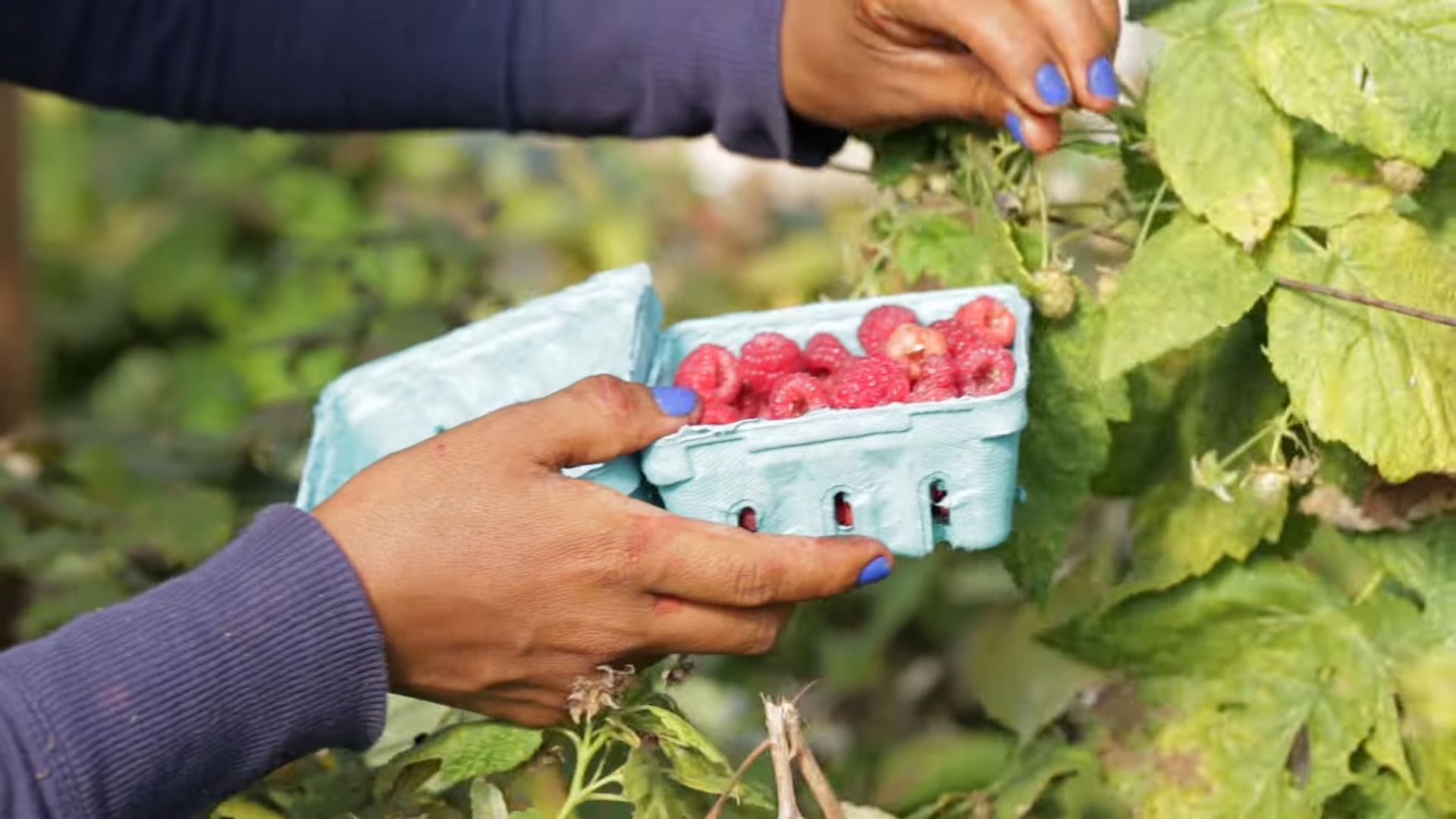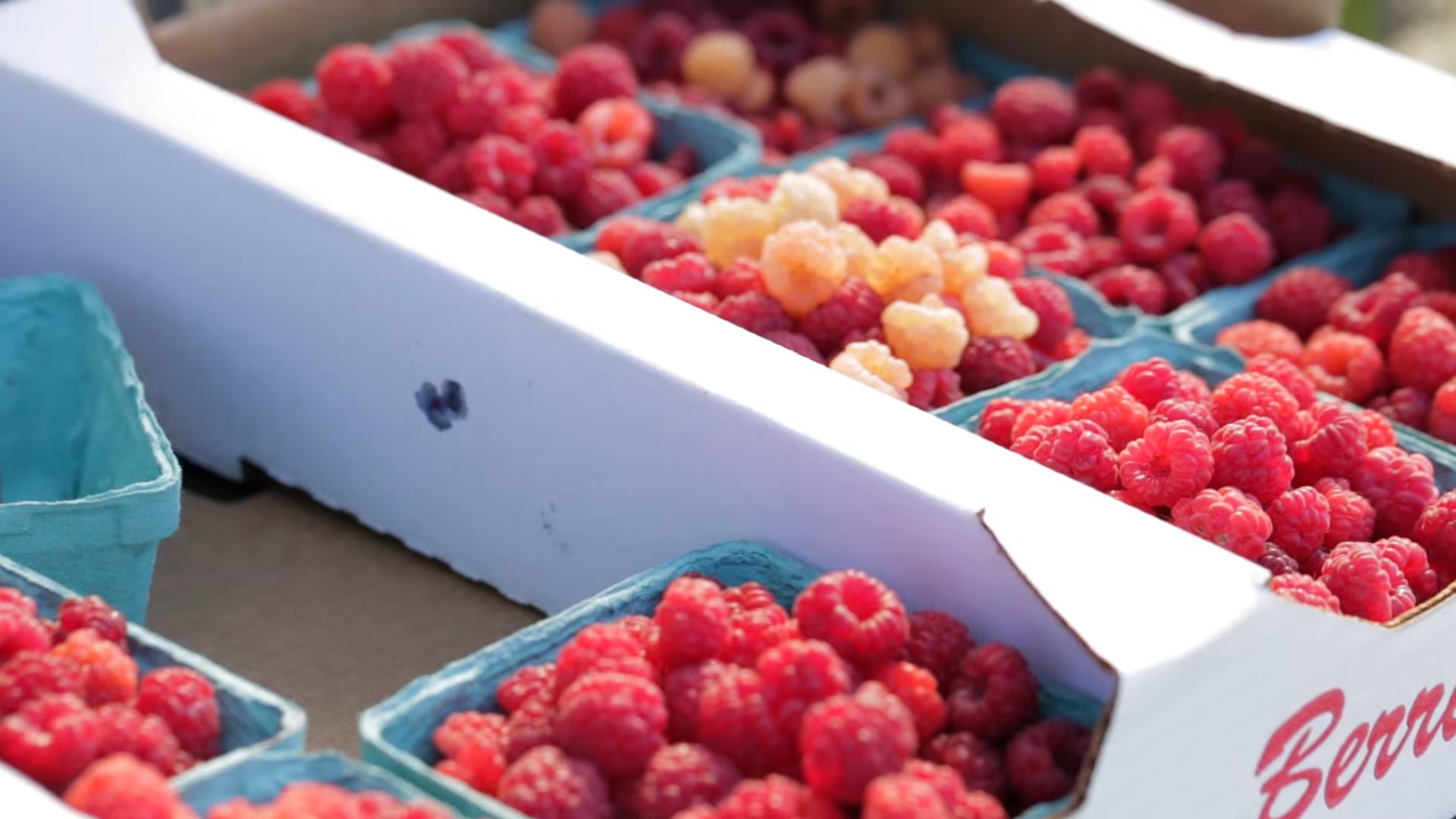Grow Raspberries at Home – imagine stepping into your backyard and plucking juicy, sun-ripened raspberries straight from the vine! Sounds like a dream, right? Well, it doesn’t have to be! For centuries, raspberries have been cherished for their delicious flavor and health benefits, with evidence suggesting their cultivation dates back to ancient Rome. But you don’t need a sprawling estate to enjoy these delectable berries.
I’m here to tell you that even with limited space, you can successfully cultivate your own raspberry patch. In this DIY guide, I’ll share my favorite tricks and hacks to help you grow raspberries at home, regardless of your gardening experience. We’ll cover everything from choosing the right variety for your climate to simple pest control methods, ensuring a bountiful harvest.
Why is this so important? Because store-bought raspberries can be expensive and often lack the intense flavor of homegrown ones. Plus, there’s nothing quite like the satisfaction of nurturing your own food from seed (or cane!) to table. So, ditch the grocery store berries and get ready to embark on a rewarding gardening adventure. Let’s get started!

Grow Your Own Delicious Raspberries: A DIY Guide
Hey there, fellow gardening enthusiasts! I’m so excited to share my experience with growing raspberries at home. There’s nothing quite like the taste of freshly picked, sun-ripened raspberries, and trust me, it’s easier than you might think to cultivate your own little berry patch. This guide will walk you through everything you need to know, from choosing the right variety to harvesting your bounty. Let’s get started!
Choosing the Right Raspberry Variety
Before you even think about digging, you need to decide which type of raspberry is right for you. There are two main types:
* Summer-Bearing Raspberries: These produce one large crop of berries in the summer, usually in June or July. They require more pruning but often yield a larger harvest at once.
* Everbearing (or Fall-Bearing) Raspberries: These produce two crops – one in the fall on the current year’s growth and another smaller crop the following summer on the previous year’s growth. Many gardeners choose to prune them to only produce the fall crop for simplicity and a larger, more concentrated harvest.
Within these two types, there are tons of different varieties, each with its own unique characteristics. Here are a few popular choices:
* ‘Heritage’ (Everbearing): This is a classic, reliable variety that’s known for its excellent flavor and disease resistance. It’s a great choice for beginners.
* ‘Caroline’ (Everbearing): Another excellent everbearing option, ‘Caroline’ produces large, flavorful berries and is also disease-resistant.
* ‘Boyne’ (Summer-Bearing): This is a very hardy variety that’s well-suited for colder climates. It produces medium-sized, sweet berries.
* ‘Latham’ (Summer-Bearing): A popular choice for its high yields and good flavor. It’s also relatively disease-resistant.
Consider your climate, the amount of space you have, and your personal taste preferences when making your decision. I personally started with ‘Heritage’ because it was recommended as a beginner-friendly option, and I haven’t been disappointed!
Preparing Your Raspberry Patch
Raspberries need a sunny spot with well-drained soil. They prefer slightly acidic soil with a pH between 6.0 and 6.8. Here’s how to prepare your planting area:
1. Choose a Location: Select a spot that gets at least 6-8 hours of sunlight per day. Avoid areas where water tends to pool, as raspberries don’t like soggy roots. Also, keep them away from wild brambles to avoid potential disease transmission.
2. Test Your Soil: A soil test will tell you the pH and nutrient levels of your soil. You can purchase a soil test kit at most garden centers or send a sample to your local agricultural extension office.
3. Amend the Soil: Based on your soil test results, amend the soil as needed. If your soil is too acidic, add lime to raise the pH. If it’s too alkaline, add sulfur to lower the pH. Incorporate plenty of organic matter, such as compost or well-rotted manure, to improve drainage and fertility. I usually add a generous layer of compost a few weeks before planting.
4. Clear the Area: Remove any weeds, grass, rocks, or other debris from the planting area. Raspberries don’t compete well with weeds, so it’s important to start with a clean slate.
5. Consider a Raised Bed: If your soil is heavy clay or poorly drained, consider planting your raspberries in a raised bed. This will improve drainage and prevent root rot.
Planting Your Raspberry Canes
The best time to plant raspberries is in early spring or late fall, when the plants are dormant. Here’s how to plant them:
1. Purchase Healthy Canes: Buy your raspberry canes from a reputable nursery. Look for plants that are healthy and disease-free. Bare-root canes are often more economical, but container-grown plants are easier to establish.
2. Soak the Roots (Bare-Root Canes): If you’re planting bare-root canes, soak the roots in water for about an hour before planting. This will help rehydrate them.
3. Dig the Holes: Dig holes that are wide enough to accommodate the roots and deep enough so that the top of the root ball is level with the ground. Space the holes about 2-3 feet apart for summer-bearing raspberries and 1.5-2 feet apart for everbearing raspberries. If you’re planting in rows, space the rows about 8-10 feet apart.
4. Plant the Canes: Gently remove the canes from their containers (if applicable) and loosen the roots. Place the canes in the holes and spread out the roots. Backfill the holes with soil, gently firming it around the roots.
5. Water Thoroughly: Water the newly planted canes thoroughly to settle the soil and provide moisture.
6. Mulch: Apply a layer of mulch around the plants to help retain moisture, suppress weeds, and regulate soil temperature. I like to use wood chips or straw.
7. Cut Back the Canes: After planting, cut back the canes to about 6-9 inches above the ground. This may seem counterintuitive, but it encourages the plants to develop strong roots.
Caring for Your Raspberry Plants
Raspberries require regular care to thrive. Here’s what you need to do:
1. Watering: Raspberries need consistent moisture, especially during dry periods. Water deeply and regularly, especially when the plants are flowering and fruiting. Aim for about 1-2 inches of water per week.
2. Fertilizing: Fertilize your raspberries in early spring with a balanced fertilizer, such as 10-10-10. Follow the instructions on the fertilizer package. You can also side-dress with compost or well-rotted manure.
3. Weeding: Keep the area around your raspberries free of weeds. Weeds compete with the plants for nutrients and water. Hand-pull weeds regularly or use a hoe. Be careful not to damage the raspberry roots.
4. Pruning: Pruning is essential for maintaining healthy and productive raspberry plants. The pruning method depends on whether you have summer-bearing or everbearing raspberries.
* Summer-Bearing Raspberries: After the summer crop is finished, prune out the canes that fruited. Cut them back to the ground. Leave the new, green canes that grew during the summer. These will produce fruit next year.
* Everbearing Raspberries: If you want to harvest two crops per year, prune out the tips of the canes that fruited in the fall after the harvest is complete. Leave the rest of the cane. These canes will produce a smaller crop in the summer. After the summer crop, prune out the canes that fruited. Alternatively, if you only want to harvest one large crop in the fall, cut all the canes back to the ground in late winter or early spring.
5. Support: Raspberry canes can become heavy with fruit and may need support. You can use a trellis, wires, or stakes to support the canes. I use a simple wire trellis system that I built myself.
6. Pest and Disease Control: Raspberries can be susceptible to various pests and diseases. Monitor your plants regularly for signs of problems. Common pests include aphids, spider mites, and Japanese beetles. Common diseases include cane blight, anthracnose, and root rot. Treat any problems promptly with appropriate organic or chemical controls. I prefer to use organic methods whenever possible.
Harvesting Your Raspberries
Harvesting is the most rewarding part of growing raspberries! Here’s what you need to know:
1. Timing: Raspberries are ready to harvest when they are fully colored and easily pull away from the stem. They should be slightly soft to the touch.
2. Technique: Gently grasp the berry and pull it away from the stem. Be careful not to crush the berries.
3. Frequency: Harvest your raspberries every few days, as they ripen quickly.
4. Storage: Raspberries are delicate and don’t store well. Eat them fresh as soon as possible. If you need to store them, refrigerate them in a single layer in a shallow container. They will last for a few days. You can also freeze raspberries for longer storage. Spread them out on a baking sheet and freeze them until solid. Then, transfer them to a freezer bag or container.
Dealing with Common Raspberry Problems
Even with the best care, you might encounter some problems when growing raspberries. Here are a few common issues and how to address them:
* Poor Fruit Set: This can be caused by a lack of pollination, poor weather conditions, or nutrient deficiencies. Ensure your plants are getting enough sunlight and water. You can also try hand-pollinating the flowers.
* Small Berries: This can be caused by a lack of water or nutrients. Water your plants regularly and fertilize them as needed.

Conclusion
So, there you have it! Growing raspberries at home isn’t just a gardening project; it’s an investment in delicious, healthy rewards that you can enjoy for years to come. We’ve walked you through the essential steps, from selecting the right raspberry variety for your climate to nurturing your plants for optimal fruit production. The beauty of this DIY project lies in its accessibility – whether you have a sprawling backyard or a sunny balcony, there’s a way to cultivate these ruby-red jewels.
Why is this a must-try? Because store-bought raspberries simply can’t compare to the burst of flavor you get from freshly picked, homegrown berries. The satisfaction of harvesting your own fruit, knowing exactly where it came from and how it was grown, is unparalleled. Plus, you’ll be saving money in the long run, reducing your carbon footprint, and enjoying a constant supply of these antioxidant-rich superfoods.
But the fun doesn’t stop there! Feel free to experiment with different raspberry varieties. Try a mix of red, black, and golden raspberries for a colorful and flavorful harvest. Consider companion planting with herbs like basil or thyme to deter pests and enhance the flavor of your berries. You can also explore different trellising methods to maximize space and support your plants. For those with limited space, dwarf raspberry varieties are perfect for container gardening. Imagine a patio overflowing with vibrant green foliage and clusters of juicy raspberries – a true testament to your green thumb!
Don’t be intimidated if you’re a beginner gardener. Growing raspberries at home is a forgiving process, and even small mistakes can be valuable learning experiences. The key is to be patient, observant, and willing to adapt your approach as needed. Remember to regularly check your plants for pests and diseases, provide adequate water and nutrients, and prune them properly to encourage healthy growth and abundant fruit production.
We’re confident that you’ll find the experience of growing raspberries at home to be incredibly rewarding. The taste of those first sun-ripened berries will be a moment to savor, and the knowledge that you nurtured them from start to finish will fill you with pride. So, grab your gardening gloves, choose your raspberry variety, and get ready to embark on this exciting adventure.
We encourage you to try this DIY trick and share your experiences with us! Let us know what varieties you chose, what challenges you faced, and what successes you celebrated. Share your photos and tips on social media using #HomegrownRaspberries. We can’t wait to see your raspberry gardens flourish! Remember, the journey of growing raspberries at home is just as enjoyable as the delicious destination. Happy gardening!
Frequently Asked Questions (FAQ)
What is the best time of year to plant raspberries?
The best time to plant raspberries depends on whether you’re planting bare-root or potted plants. Bare-root raspberries are typically planted in early spring or late fall when the plants are dormant. This allows them to establish their root systems before the growing season begins. Potted raspberries, on the other hand, can be planted throughout the growing season, as long as you provide them with adequate water and care. However, planting in spring or early fall is still generally recommended for optimal results. Consider your local climate and the specific recommendations for your chosen raspberry variety when determining the best planting time.
What kind of soil do raspberries need?
Raspberries thrive in well-drained, slightly acidic soil with a pH between 6.0 and 6.8. The soil should be rich in organic matter to provide essential nutrients and improve drainage. Before planting, amend the soil with compost, well-rotted manure, or other organic materials to enhance its fertility and structure. Avoid planting raspberries in heavy clay soil, as this can lead to root rot. If you have clay soil, consider planting in raised beds or containers to improve drainage. A soil test can help you determine the pH and nutrient levels of your soil and guide you in making necessary amendments.
How much sun do raspberries need?
Raspberries require at least six to eight hours of direct sunlight per day to produce abundant fruit. Choose a planting location that receives full sun, especially during the morning hours. While raspberries can tolerate some afternoon shade, too much shade can reduce fruit production and increase the risk of diseases. If you live in a hot climate, providing some afternoon shade can help protect the plants from excessive heat stress. Monitor your plants throughout the growing season and adjust their location if necessary to ensure they receive adequate sunlight.
How often should I water my raspberry plants?
Raspberry plants need consistent moisture, especially during the growing season and when the fruit is developing. Water deeply and regularly, aiming to keep the soil consistently moist but not waterlogged. The frequency of watering will depend on factors such as the weather, soil type, and plant size. Check the soil moisture regularly by sticking your finger into the soil a few inches deep. If the soil feels dry to the touch, it’s time to water. Avoid overhead watering, as this can increase the risk of fungal diseases. Instead, use a soaker hose or drip irrigation system to water the plants at the base.
How do I prune my raspberry plants?
Pruning is essential for maintaining the health and productivity of raspberry plants. The pruning techniques vary depending on whether you have summer-bearing or everbearing raspberries. Summer-bearing raspberries produce fruit on the previous year’s canes. After harvesting the fruit, prune out the canes that fruited, cutting them back to the ground. Leave the new canes that grew during the current season, as these will produce fruit next year. Everbearing raspberries produce fruit on the tips of the current year’s canes in the fall. You can either prune the entire cane to the ground in late winter or early spring for one large crop in the fall, or you can prune only the top portion of the cane that fruited in the fall and leave the remaining portion to produce a smaller crop in the summer. Regardless of the type of raspberry, remove any weak, damaged, or diseased canes to improve air circulation and prevent the spread of diseases.
What are common pests and diseases that affect raspberries?
Raspberries are susceptible to various pests and diseases, including aphids, spider mites, raspberry cane borers, anthracnose, and root rot. Regularly inspect your plants for signs of pests or diseases and take action promptly to prevent them from spreading. Use organic pest control methods such as insecticidal soap, neem oil, or horticultural oil to control aphids and spider mites. Remove and destroy any canes that are infested with raspberry cane borers. To prevent anthracnose, ensure good air circulation around the plants and avoid overhead watering. Improve soil drainage to prevent root rot. Consider planting disease-resistant raspberry varieties to minimize the risk of disease problems.
Can I grow raspberries in containers?
Yes, you can successfully grow raspberries in containers, especially if you have limited space. Choose a large container with drainage holes and fill it with a well-draining potting mix. Select a dwarf or compact raspberry variety that is well-suited for container gardening. Provide the plants with adequate sunlight, water, and nutrients. Fertilize regularly with a balanced fertilizer. Prune the plants as needed to maintain their shape and size. Container-grown raspberries may require more frequent watering and fertilization than those grown in the ground.
How long does it take for raspberry plants to produce fruit?
The time it takes for raspberry plants to produce fruit depends on the variety and the planting method. Bare-root raspberries typically take one to two years to produce a significant crop of fruit. Potted raspberries may produce fruit in their first year, but the yield will likely be smaller than that of established plants. Summer-bearing raspberries produce fruit in the summer, while everbearing raspberries produce fruit in the fall. Be patient and provide your plants with proper care, and you’ll be rewarded with delicious raspberries in due time.





Leave a Comment